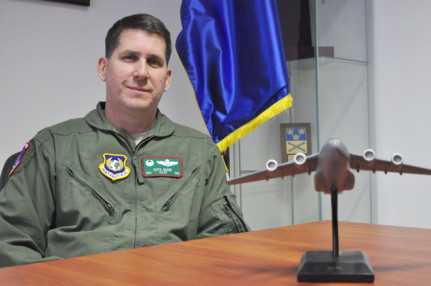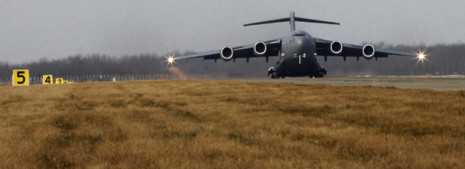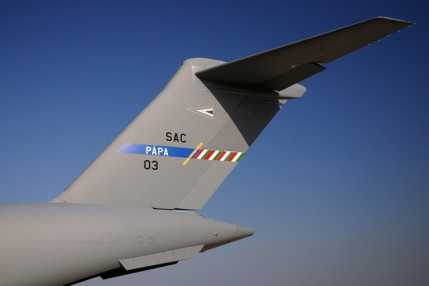One from Twelve
Szöveg: Gábor Kálmánfi | 2012. december 15. 7:23As reported in an earlier article, the Heavy Airlift Wing stationed at the HDF Pápa Air Base reached Full Operational Capability on November 14. Colonel Keith P. Boone, the commander of the international military organization gave us an exclusive interview on the processes leading up to this stage and the long-term goals.

Colonel, the Wing has reached Full Operational Capability. Can you please tell us about the details?
“On reaching the initial operational capability (IOC) we already began flying our mission sets, but we had still to do a lot of work to reach the next milestone, the full operational capability (FOC) this November. Full Operational Capability included a few things: we had to make sure that we had the right amount of personnel so that the people on the wing were ready to execute the mission. There also needed to be processes and procedures in place at the Wing, as well as reliable resources and equipment so we can do the missions. As we rotated new members in, old members out, we needed to make sure that we are able to sustain training and not just have a one-time training for the members of the Heavy Airlift Wing. The other thing was to have the right number of aircraft and to make sure that their reliability was there with the maintenance so that we can generate the missions that we need to fly for the nations. Another thing we needed to have was a logistics line, which is vital to sustaining the supplies.
Full Operational Capability (FOC) means essentially that we have all the things that we need to do the missions. But as a commander, to me the key factor in declaring FOC was to say it’s not just this year, but it’s the year after too, because let us not forget that it’s a thirty-plus year program. FOC is all about that we reached this stage in the SAC program where we are able to meet the nations’ requirements. The nations participating in the program have invested a certain amount of money to be able to fly a certain amount of flight hours with the Strategic Airlift Capability. To reach FOC means that we’re able to give payback on that investment for the nations that fly the strategic airlift missions that they need, when they need that with the resources we have. 3165 flight hours is the amount that we’re supposed to be able to fly annually, collectively for all the nations, and we must be able to do it repeatedly year after year.
What was the most difficult stage to reach in this process?
It’s hard to say that it’s any one thing because each element is critical in its own regard. Having the right amount of people is critical, just like having a training system and a logistic supply system. Certainly, one of the key things that was decided early on in the program – which has been foundational to our success – was the establishing of common baselines for the instructions and regulations that we use. These were also fundamental to our safety record and our training too. As the US Air Force has been flying C-17s since 1993, it has a proven system for training and for all the other instructions and regulations that go along with having safe flight operations. We have soldiers of twelve nations serving here, so we had to make sure that we provide a common baseline, so everyone starts with the same knowledge base, because our members are coming with different experiences from different training systems. It was key to us to be able from the start to build a cohesive team, and to continue with safe flight operations. We started using the US Air Force instructions and then figured out where things might be different here and changed them where necessary to make them right, according to the characteristics of the Wing. So we use a proven safe system for flying the aircraft of the Heavy Airlift Wing.

The HAW is considered an exceptional military unit by many. How are you able to put all these twelve nations together, to have them work together smoothly?
One of the keys is focusing on the mission. The reason why everyone is here – whether they are members of the Heavy Airlift Wing, the NATO Airlift Management Program Office (NAMPO), the Boeing or Pápa Air Base, or are family members – the singular thing that we all here do is to fly strategic airlift for the nations when and where they need it. Setting a vision also helps bringing people together. It’s twelve nations but it’s one team, with one mission and one vision. If anywhere in the world people ask “What is the best organization for flying strategic airlift with C-17s?" they should look and say it’s the Heavy Airlift Wing in Pápa, Hungary. That’s our long-term goal. We are always looking to the next thing we can do to make ourselves incrementally better and get new resources. One such development can be the building of a C-17 hangar which will provide us with a better place to do planned and unplanned maintenance on the aircraft to meet shorter deadlines in a more cost-effective way.
I have seen a poster hanging on the wall of the corridor with the commander’s priorities written on it. I think they also contribute to making the Wing a cohesive team.
I have established six priorities that I used to meet our mission set. The first is a healthy and good work environment. The second is that everyone should focus on the mission, and focus on how we can generate all our resources on that singular thing. The third is that I want to capitalize on the national pride, which is patriotism. It says “I am very proud of the country I come from, and I bring that energy into this organization, into being a great part of the team." It is very important not to mistake this pride for nationalism, which says “I think I’m better than you because I wear this flag, and I tell you how to do things because I’m better than you." This attitude is totally unacceptable. The fourth thing is that the family members here in Pápa are critical to our success. If my family is not happy, then I’m going to have a hard time focusing on the mission. So as the HAW commander, I’ve made a very strong quest to make sure that all the families have the resources that they should have to be able to live comfortably in Pápa. The fifth point is that we need to be gracious guests in Hungary, but we are also citizens of Pápa, so we have an obligation to represent our own nations and military organizations while we’re here, and we have to participate in the town’s events and the life of the community. The sixth and last point is to have a long-term vision. I’ve already mentioned that this is a thirty-plus year program, so we need to take a long view, and not just do what is convenient or expedient to do now.
I think it must also be critical how you can work together with the personnel on Pápa Air Base.
Hungary has several distinct places in this program. First, they are a member nation of the Strategic Airlift Capability, so they are just one of the twelve. But they also are the host nation for the program, so the nation has responsibilities, obligations and interest in making sure that the program is going well from that perspective. It is the flag nation and sending nation for the aircraft, which means if you look at the tail flash it says “Pápa", and all the aircraft have the Hungarian military tail flash on them. There are only a few nations that have that, so Hungary should take pride in its role in the SAC program. Pápa Air Base is the host base of this program as the main operating base. We are working very closely with the base leadership, including Lt Col László Gangler, the commander of the base. He and the previous commanders have all recognized the need to work closely with us. And we communicate daily, it’s not just a partnership on the mission but it’s a friendship. We’re working very closely in order to make sure that we’re working through all the issues. It’s a good program, and in lots of ways it has not been done before. In some respect there are other models that are similar, but nothing quite the same. Having good cooperation is also critical because the base provides a great variety of resources and technical infrastructure for the success of our mission.

In an earlier interview, you depicted the Heavy Airlift Wing as a house which is very nice from the outside but there are so many things yet to be done inside. Is this depiction still valid after reaching the Full Operational Capability?
I think we’re moving on the right way, but there’s a lot of movement yet to be done in this program before we’re totally there. As for the evolution of our operation, here’s another analogy that I’d like to share with you, one that is related to Hungary. I think we are like a Rubik’s cube. It has multiple colors which you have to get all lined up in the right way, starting with the corners and continuing with the edges, progressing step by step towards the desired end state. And there are many aspects to this program that you have to get right. For instance, you might have the best instructor pilot from the United States, but it’s no use if he’s a bad diplomat, bad at interacting with other nations. Everybody needs to be trained in multiple aspects of the mission, because this is the only way for us to go forward.
How would you evaluate the job done by the Hungarian staff at the Wing?
All nine Hungarian soldiers assigned to the Wing – three officers and six NCOs – are very qualified professionals who are doing a great job for the mission of the Heavy Airlift Wing.
I think Hungary and the Hungarian Defence Forces can be very proud of them. They all share their energy and expertise well beyond their normal duties to help us make our mission a success. The biggest challenge to us coming to Pápa, Hungary in integrating is the language. Having members that are familiar with the language can help all of us get integrated better. All this shows that Hungary has been a very gracious nation for hosting the SAC program. Let me finally add that there are a lot of things that we can continue to work on cooperatively within the program – and this is an exemplary cooperation indeed – to make further improvements, to make things even better.
Photos: Ferenc Pap, Zrínyi Media archive and the author